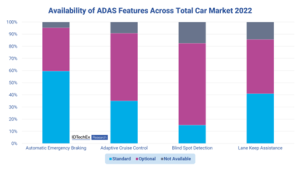Now that Mercedes is rolling out driverless SAE level 3 technologies in Germany and the US, the question that everyone in the automotive market is asking is, “when and how will this trickle down to mass market?”IDTechEx’s new report, “Autonomous Cars, Robotaxis and Sensors 2024-2044“, provides the answer
Time and again, Mercedes’ flagship luxury sedan, the S-Class, has been the trailblazer and trendsetter when it comes to future technologies for passenger cars. It may not always be the first to adopt a new technology.
In fact, Honda technically beat it to level 3 vehicles. But it is iconic for honing new features and setting the pace for the industry. Its level 3 certification in Germany and the US means that, for the first time, drivers in these regions will be able to take their hands off the wheel, feet off the pedals, and mind off the driving.
Others will soon join the level 3 club. Tesla, General Motors, and Ford can all offer hands-free driving on highways in the US, but none of these systems are certified for level 3. This distinction means that the driver always needs to pay attention to what the vehicle is doing. Moreover, the driver is always responsible for the vehicle, and if there is an accident, then blaming it on the cars driving will likely not hold up in court. However, now that Mercedes has a certified level 3 vehicle, these will quickly respond.
Even these are not mainstream vehicles though. Tesla now charges US$15,000 for its top of the line “full self-driving” features, while Super Cruise and Blue Cruise from GM and Ford, respectively, are only available on top-end vehicles. It will take a little longer for the technology to trickle down to mass market.
The total car market has been automating slowly over time, with advanced driver assistance system (ADAS) features growing in adoption and capability. Today it is hard to purchase a vehicle without features like automatic emergency braking (AEB), adaptive cruise control, or lane keep assistance systems (LKAS). In fact, IDTechEx has measured that the number of level 2 vehicles, which combine ACC and LKAS, has grown 20% between 2021 and 2022.
In 2023 IDTechEx expects level 2 vehicles to account for nearly 41% of new car sales, nearly double the estimated 21% in 2020.
Features like ACC and LKAS could now be called mainstream, with 91% of cars sold today either having ACC as standard or an option and 86% for LKAS. However, it has taken more than 15 years to get to this point, with LKAS first being seen in 2007 and ACC in 1999. Fittingly it was the Mercedes S-Class that first adopted an ACC system that controlled the throttle and brakes to maintain a gap to the vehicle ahead. So, the question is, will it take another 15 years, 20 years, or even more for SAE level 3 to be considered a mainstream technology? And beyond that, how long will the industry be waiting for level 4 systems?
 Understanding and predicting the emergence and spread of level 3 technologies requires a deep understanding of how the car market operates as well as historical trends in the industry. IDTechEx’s autonomous vehicles research and “Autonomous Cars, Robotaxis and Sensors 2024-2044” report closely follows and analyses automated technologies in the car market.
Understanding and predicting the emergence and spread of level 3 technologies requires a deep understanding of how the car market operates as well as historical trends in the industry. IDTechEx’s autonomous vehicles research and “Autonomous Cars, Robotaxis and Sensors 2024-2044” report closely follows and analyses automated technologies in the car market.
The report offers analysis of more than 4,000 car brochures dating back decades and its detailed database of ADAS availability in more than 150 of the best-selling vehicles around the world.
This detail guides IDTechEx 20-year car forecasts split by SAE level from 0 to 4, as well as emerging robotaxis and autonomous mobility as a service.
©Copyright MOTORING WORLD INTERNATIONAL. All rights reserved. Materials, photographs, illustrations and other digital content on this website, may not be reproduced, published, broadcast, rewritten or redistributed in whole or in part without prior written permission from Motoring World International
Contact: editor@motoringworldng.com





